科学美国人的中文翻译
- 格式:doc
- 大小:61.00 KB
- 文档页数:10

考研英语圣经——历年真题长难句900句翻译及语法详解There is just one path for a lawyer in most American states: a four-year undergraduate degree in some unrelated subject, then a three-year law degree at one of 200 law schools authorized by the American Bar Association and an expensive preparation for the bar exam.【翻译】在美国大部分州成为一名律师只有一条途径:学生要先获得其他专业的四年本科学历,再在由美国律师协会授权的 200 所法律学校中的一所学校中学习三年获得法律学位,而且准备律师资格考试也需要昂贵的费用。
【句子结构分析】There is just one path ①for a lawyer in most American states: ②a four-year undergraduate degree in some unrelated subject, then a three-year law degree at one of 200 law schools authorized by the American Bar Association and an expensive preparation for the bar exam.本句为简单句,句子主干 There is just one path 为 there be 句型。
①for a lawyer 为介词结构作状语,表示对象;其后的 in most American states为介词结构地点状语;②并列的名词结构 a four-year undergraduate degree...a three-year law degree...and an expensive preparation... 作同位语,解释说明 one path;其中 in some unrelated subject 为介词结构作后置定语,修饰 a four-year undergraduate degree;at one of 200 law schools 为介词结构作后置定语,修饰 a three-year law degree;authorized by the American Bar Association为过去分词结构作后置定语,修饰 200 law schools;In fact, allowing non-lawyers to own shares in law firms would reduce costs and improve services to customers, by encouraging law firms to use technology and to employ professional managers to focus on improving firms' efficiency.和雇用专业经理专门提高公司运营的效率,有助于减少成本,提高服务质量。
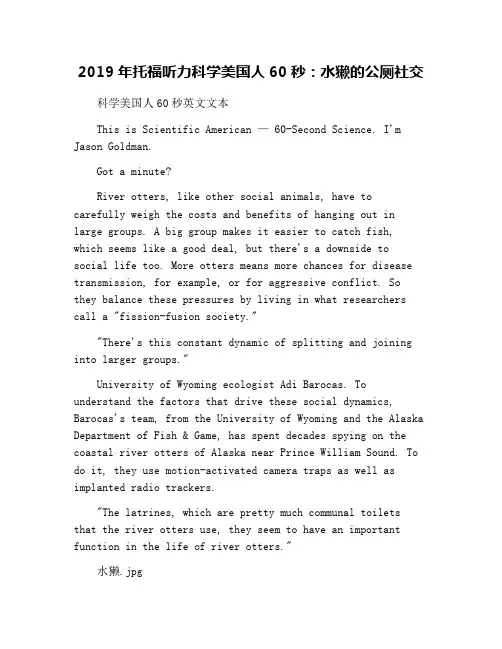
2019年托福听力科学美国人60秒:水獭的公厕社交科学美国人60秒英文文本This is Scientific American — 60-Second Science. I'm Jason Goldman.Got a minute?River otters, like other social animals, have tocarefully weigh the costs and benefits of hanging out in large groups. A big group makes it easier to catch fish, which seems like a good deal, but there's a downside tosocial life too. More otters means more chances for disease transmission, for example, or for aggressive conflict. So they balance these pressures by living in what researchers call a "fission-fusion society.""There's this constant dynamic of splitting and joining into larger groups."University of Wyoming ecologist Adi Barocas. To understand the factors that drive these social dynamics, Barocas's team, from the University of Wyoming and the Alaska Department of Fish & Game, has spent decades spying on the coastal river otters of Alaska near Prince William Sound. To do it, they use motion-activated camera traps as well as implanted radio trackers."The latrines, which are pretty much communal toiletsthat the river otters use, they seem to have an important function in the life of river otters."水獭.jpgThat's right: river otter society is organized aroundthe bathroom. It makes good sense. By investigating a latrine, an otter can sniff out just how many otters there are in the area, and who they might be.The researchers found that the otters performed more signaling behaviors like sniffing, body rubbing, or urinating, than social behaviors, like grooming or play, at what they called crossover latrines, which were located at thejunctions of water bodies.Thanks to all that communicative signaling, these crossover latrines were also more likely to host fusion events, resulting in large aggregations of up to eighteen otters. In other words, the otters see latrines as a place to exchange information, a sort of central marketplace.Because the location of crossover latrines was determined by the physical landscape, this suggests that the complexityof the physical environment plays an important role in determining their social behavior.Next, the researchers want to see just how and what the otters communicate at latrines."We often see the river otters sniffing at the latrines and also defecating, and before defecating they do a little ritualized behavior that we termed 'the poop dance.'"What scents are they trying to sniff out? Which olfactory compounds are at play? Can the otters control the scents they leave behind? Who's watching the poop dance?And most importantly, why doesn't anybody ever rememberto flush?Thanks for the minute for Scientific American — 60-Second Science Science. I'm Jason Goldman.科学美国人60秒中文翻译:This is Scientific American — 60-Second Science. I'm Jason Goldman. 这里是科学美国人——60秒科学。
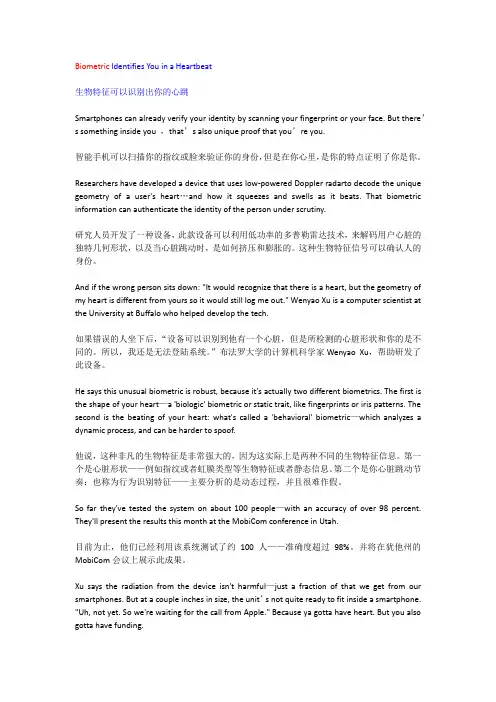
Biometric Identifies You in a Heartbeat生物特征可以识别出你的心跳Smartphones can already verify your identity by scanning your fingerprint or your face. But there’s something inside you ,that’s also unique proof that you’re you.智能手机可以扫描你的指纹或脸来验证你的身份,但是在你心里,是你的特点证明了你是你。
Researchers have developed a device that uses low-powered Doppler radarto decode the unique geometry of a user's heart…and how it squeezes and swells as it beats. That biometric information can authenticate the identity of the person under scrutiny.研究人员开发了一种设备,此款设备可以利用低功率的多普勒雷达技术,来解码用户心脏的独特几何形状,以及当心脏跳动时,是如何挤压和膨胀的。
这种生物特征信号可以确认人的身份。
And if the wrong person sits down: "It would recognize that there is a heart, but the geometry of my heart is different from yours so it would still log me out." Wenyao Xu is a computer scientist at the University at Buffalo who helped develop the tech.如果错误的人坐下后,“设备可以识别到他有一个心脏,但是所检测的心脏形状和你的是不同的。
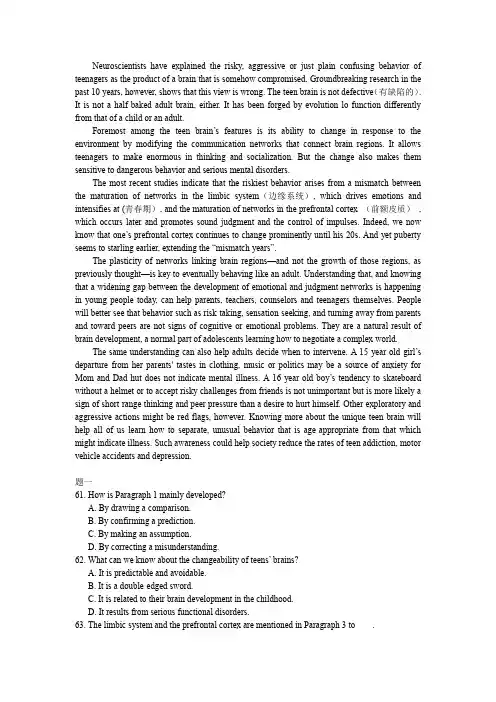
Neuroscientists have explained the risky, aggressive or just plain confusing behavior of teenagers as the product of a brain that is somehow compromised. Groundbreaking research in the past 10 years, however, shows that this view is wrong. The teen brain is not defective(有缺陷的). It is not a half-baked adult brain, either. It has been forged by evolution lo function differently from that of a child or an adult.Foremost among the teen brain’s features is its ability to change in response to the environment by modifying the communication networks that connect brain regions. It allows teenagers to make enormous in thinking and socialization. But the change also makes them sensitive to dangerous behavior and serious mental disorders.The most recent studies indicate that the riskiest behavior arises from a mismatch between the maturation of networks in the limbic system(边缘系统), which drives emotions and intensifies at (青春期), and the maturation of networks in the prefrontal cortex (前额皮质), which occurs later and promotes sound judgment and the control of impulses. Indeed, we now know that one’s prefrontal cortex continues to change prominently until his 20s. And yet puberty seems to starling earlier, extending the “mismatch years”.The plasticity of networks linking brain regions—and not the growth of those regions, as previously thought—is key to eventually behaving like an adult. Understanding that, and knowing that a widening gap between the development of emotional and judgment networks is happening in young people today, can help parents, teachers, counselors and teenagers themselves. People will better see that behavior such as risk-taking, sensation-seeking, and turning away from parents and toward peers are not signs of cognitive or emotional problems. They are a natural result of brain development, a normal part of adolescents learning how to negotiate a complex world.The same understanding can also help adults decide when to intervene. A 15-year-old girl’s departure from her parents' tastes in clothing, music or politics may be a source of anxiety for Mom and Dad hut does not indicate mental illness. A 16-year-old boy’s tendency to skateboard without a helmet or to accept risky challenges from friends is not unimportant but is more likely a sign of short-range thinking and peer pressure than a desire to hurt himself. Other exploratory and aggressive actions might be red flags, however. Knowing more about the unique teen brain will help all of us learn how to separate, unusual behavior that is age-appropriate from that which might indicate illness. Such awareness could help society reduce the rates of teen addiction, motor vehicle accidents and depression.题一61. How is Paragraph 1 mainly developed?A. By drawing a comparison.B. By confirming a prediction.C. By making an assumption.D. By correcting a misunderstanding.62. What can we know about the changeability of teens’ brains?A. It is predictable and avoidable.B. It is a double-edged sword.C. It is related to their brain development in the childhood.D. It results from serious functional disorders.63. The limbic system and the prefrontal cortex are mentioned in Paragraph 3 to .A. show how the mismatch between their maturation of networks happensB. explain the relationship between early puberty and themC. explain what leads to teens’ riskiest behaviorD. show the differences between them64. What are the last two paragraphs mainly about?A. The important role of adults in teenagers, development.B. Long-term prospects for the research of teenagers’ br ains.C. Possible cognitive and emotional problems of teenagers.D. The significance of the new discovery.C篇61.D。
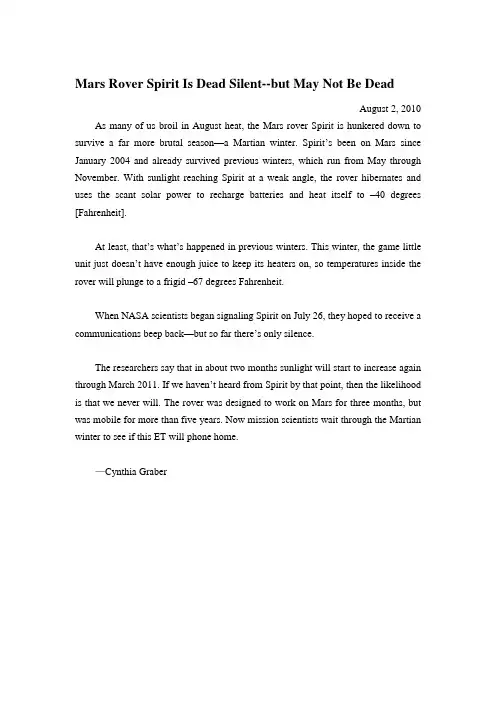
Mars Rover Spirit Is Dead Silent--but May Not Be DeadAugust 2, 2010 As many of us broil in August heat, the Mars rover Spirit is hunkered down to survive a far more brutal season—a Martian winter. Spirit’s been on Mars since January 2004 and already survived previous winters, which run from May through November. With sunlight reaching Spirit at a weak angle, the rover hibernates and uses the scant solar power to recharge batteries and heat itself to –40 degrees [Fahrenheit].At least, that’s what’s happened in previous winters. This winter, the game little unit just doesn’t have enough juice to keep its heaters on, so temperatures inside the rover will plunge to a frigid –67 degrees Fahrenheit.When NASA scientists began signaling Spirit on July 26, they hoped to receive a communications beep back—but so far there’s only silence.The researchers say that in about two months sunlight will start to increase again through March 2011. If we haven’t heard from Spirit by that point, then the likelihood is that we never will. The rover was designed to work on Mars for three months, but was mobile for more than five years. Now mission scientists wait through the Martian winter to see if this ET will phone home.—Cynthia GraberPhysics Students Reveal Bias for Male LecturersAugust 3, 2010 Why aren’t there more women physicists, and in senior positions? One factor may be unconscious biases that could keep women physicists from advancing—and may even prevent women from going into physics in the first place.Amy Bug, a physicist at Swarthmore College, examined the bias question.* Her research team trained four actors—two men, two women—to give a 10-minute physics lecture. Real physics classes watched the lecturers. Then the 126 students were surveyed.When it came to questions of physics ability—whether the lecturer had a good grasp of the material, and knew how to use the equipment—male lecturers got higher ratings by both male and female students.But when asked how well the lecturer relates to the students, each gender preferred their own. And while female students gave a slight preference to female lecturers, male students overwhelmingly rated the male lecturers as being superior. The research appears in the journal Physics World. [http://bit.ly/b3ctOj]Bug says the results may be evidence of inherent biases that could hold women back—along with economic inequalities, such as lower wages and smaller start-up grants. Which reduce career acceleration and thus the amount of force available to crack the glass ceiling.—Cynthia Graber*Correction (8/3/10): This sentence has been edited to correct an error conveyed by this podcast. Swarthmore College was originally identified as Swarthmore University.Hot Peppers' Capsaicin Helps Hypertensive RatsAugust 4, 2010 Here’s a possible blood pressure remedy. But it’s only for those who can stand the heat. It’s capsaicin, the “active ingredient” in peppers like habaneros that should probably be sold by prescription only. While lips burn and eyes water, blood vessels actually relax, thanks to increased production of the signaling molecule nitric oxide. In rodents, anyway.For seven months, researchers in China fed a steady diet of capsaicin to rats bred to be hypertensive. Long-term consumption of the chemical substantially lowered the rats’ blood pressure. The results appear in the August issue of the journal Cell Metabolism. [Dachun Yang et al., http://bit.ly/aLcuZZ]Previous research found mixed results with capsaicin, but those studies only looked at short-term effects. Human trials are needed, but there’s already a clue. Some 20 percent of people in northeastern China have high blood pressure. But the southwest—where hot peppers are a dietary staple—has a much lower incidence, half in some places.Human studies could also confirm whether the habanero, as legend has it, can cause hearing loss. Allegedly so that diners don’t have to listen to their own screams.—Adam Hinterthuer[The above text is an exact transcript of this podcast.]Audio Finds Frog Counters May Be OverestimatingAugust 5, 2010 Declining frog populations are considered an indicator of environmental damage. But new research finds that frogs might be doing even worse than we thought. Because the volunteers who count frogs by their sounds may be overestimating.The North American Amphibian Monitoring Program is the country’s largest frog-counting system. Volunteers listen for frogs, identify the species, and give population estimates. They’ve been doing this for over a decade.Ted Simons from North Carolina State University and colleagues put recordings of frogs, like this wood frog, [Wood Frog sound] in the field to test the volunteers. They call it Ribbit Radio.Many volunteers ended up with false positives—they named frog species whose calls weren’t being played. So there may be fewer frogs, or less variety, than the surveys suggest. The results appear in the journal Ecology. [Brett McClintock et al., http://bit.ly/9iPhUs]Simons is working with the U.S. Geological Survey—in charge of the amphibian monitoring—to account for these false positives, and to better train the volunteers—so they don’t write down “chorus frog” [Chorus Frog sound] when all there really was were pickerel frogs. [Pickerel Frog sound] Apparently, it’s not easy being green, for humans either.—Cynthia Graber[The above text is an exact transcript of this podcast.]Transgenic Canola Plants Break Free of FarmAugust 6, 2010 One of the concerns about working with genetically modified crops has been that vegetation growing in agricultural fields might escape out into the world. Now, for the first time in the U.S., researchers report a large population of GM crops beyond the farm.Transgenic canola plants in North Dakota had received genes making them resistant to herbicides, such as the weed killer Roundup. Researchers collected and tested 406 canola plants along thousands of miles of state roads. They found 347 carrying at least one resistance gene. There were also indications that the inserted genes were being passed on to new generations, producing some plants in the wild with multiple transgenes. The findings were presented on August 6th at the annual meeting of the Ecological Society of America in Pittsburgh. [Meredith Schafer et al., University of Arkansas]The transgenic canola plants are not about to take over the world. But researchers are obviously curious about how these particular plants managed to make it in places like the edges of parking lots rather than pampered fields. Any answers they find will likely affect future biotechnology regulation.—Molly Webster[The above text is an exact transcript of this podcast]Blue Whales Synchronize Song PitchAugust 9, 2010 Blue whales off the California coast make calls that, sped up 10 times, sound like (sound of two-part call). The original is a wall-rattling frequency too low for us to hear. Scientists analyzed around 2,500 of those calls, and found that the second part (sound) is nearly identical in pitch every time from each whale: 16 hertz, or four octaves below middle C. And the slight variations in frequency that do exist are only a tenth of the difference between a C and a C sharp. Those findings appear online in the Journal of the Acoustical Society of America. [Michael Hoffman, Newell Garfield and Roger Bland, http://bit.ly/9oCoP0]The researchers don't know how many different individual whales they caught singing, or why even they sing at all. But past studies suggest only blue whale males make calls like this. So the investigators speculate that males might synchronize to a single common pitch as a sort of mating beacon.Thanks to the Doppler effect, females swimming towards a male would hear a slightly higher pitch; swimming away, a lower-pitched moan. Serenade out of tune—you might be swimming solo tonight.--Christopher Intagliata[The above text is an exact transcript of this podcast.]Case Study: Tongue Stud Play Causes Front Teeth GapAugust 10, 2010 That’s what it might sound like if I had a tongue stud, hitting my teeth. Maybe you’ve seen people with studs in their tongue clicking it up against their front teeth, a move known as “playing.” But it turns out that the habit may destroy some smiles.University of Buffalo researchers noticed that local high school students who had a barbell-type tongue stud commonly pushed the piercings against their front teeth. Then they examined a 26-year-old patient at the school’s dental clinic. She’d had been complaining about a large gap that had developed between her front two teeth. Seven years previously, she got a tongue stud. And every day, for seven years, she pushed that stud up against her teeth.The researchers say tongues are strong, and it makes sense that the force of “playing” will move teeth, even forcing them apart. The case was written up in the Journal of Clinical Orthodontics. [Sawsan Tabbaa, Ivanka Guigova and C. Brian Preston, ]Tongue piercings have also been associated with infections, chipped or broken teeth, and gum trauma. And the patient? She got braces to push her teeth back together. Which probably didn’t look quite as cool as she thought the tongue stud was.—Cynthia Graber[The above text is an exact transcript of this podcast.]Almost a Million Years Added for Earliest HumanAncestor Stone Tool Use and Meat-EatingAugust 11, 2010 There’s nothing like a good steak. And our Australopithecus afarensis ancestors apparently felt the same way. Because new discoveries from Ethiopia show that what was likely the species of the famous fossil Lucy used stone tools to butcher meat from big mammals—about 3.4 million years ago. That’s a million years earlier than our best previous evidence for human ancestor stone tool use and meat eating. The finding appears on the cover of the journal Nature. [Shannon P. McPherron et al., http://bit.ly/dzCs4d]The research team found two fossil bones with cut and scrape marks, signs of meat carving. One bone was a piece of rib from a cow-sized mammal; the other, a leg bone fragment from a mammal the size of a goat. The bones also had percussion marks, sustained while Lucy’s friends smashed the bones to get at the marrow.It looks like the ancient tool users collected stones that happened to have shapes conducive to butchering, the way kids select particular stones with good potential to skip on water. But future expeditions will look for evidence for any attempts at shaping stones into kitchen utensils. Because after 3.4 million years, Lucy and her fellow afarensis keep surprising us.—Steve Mirsky[The above text is an exact transcript of this podcast.]Sound Sleepers' Brain Waves Block SoundsAugust 12, 2010 Ahhh, sleep. There’s nothing better than a nice, long, uninterrupted [LOUD NOISE]. Awwgh. I can’t sleep when there’s [NOISE]. But d’ya ever notice: noise [NOISE] doesn’t wake everyone. Now scientists have a better idea why. Because sound sleepers show a certain brain rhythm when they doze, findings published in the journal Current Biology. [Thien Thanh Dang-Vu et al., http://bit.ly/cORe7D]To study the brain waves of a good night’s sleep, scientists invited volunteers to snooze in the lab. While the subjects caught some Zs, the researchers monitored their brain activity. They then subjected the sleepers to [NOISE] or [NOISE]. And they found that those who were able to slumber straight through all the [NOISE] showed more short bursts of faster brain waves. This activity, the scientists say, is the brain’s way of blocking out the [NOISE] and the [NOISE] while you’re trying to rest.The scientists don’t yet know of any way to boost those sleep-saving brain waves. So until then, shut the door [DOOR SHUTTING], make sure the late show’s on a timer [TV SOUND], and try to have sweet dreams.—Karen Hopkin[The above text is an exact transcript of this podcast.]Pour Champagne on the Side for Better FlavorAugust 13, 2010 You don't have to be a champagne buff to want the best flavor from your bubbly. So the secret to a perfect glass? It's all in the pour, according to a study in the Journal of Agricultural and Food Chemistry. [Gerard Liger-Belair et al., http://bit.ly/cmmEOH]A key player in champagne's taste is its dissolved carbon dioxide. As that CO2 bubbles out, it releases aroma, and provides that tingly bite. As soon as you uncork a bottle, CO2 starts diffusing from the champagne into the air. But pouring it speeds up that process, by increasing surface area and turbulence.Chemists—French ones, of course—poured champagne into fluted glasses two ways. The traditional way, straight down, splashing off the bottom—and the beer way, onto the side of a tilted glass. Then they measured the CO2 lost during the pour.At 40 degrees Fahrenheit, champagne poured traditionally quickly lost a quarter of its carbon dioxide. But pouring down the side caused only half the gas loss. Closer to room temperature, the drink became flat fast, whatever way you pour. So if you want your champagne très bon, keep it cold. And pour that bubbly like it’s Bud.—Christopher Intagliata[The above text is an exact transcript of this podcast.]Invasive Species Lets Other Species Disrupt EnvironmentAugust 16, 2010 At Point Reyes National Seashore in Marin County, California, a plant called Tidestrom’s lupine is holding on for dear life. Its survival has been threatened by the appearance of another plant, an invasive species called European beachgrass. So, does the beachgrass simply outcompete the lupines for land and light? Not at all, according to researchers at Washington University in St. Louis.Tiny deer mice have a taste for the seeds of the lupines. These critters would ordinarily think twice about approaching the plants. Because exposed out on the sand, they’re easy pickings for birds interested in a rodent repast. But the beachgrass provides excellent cover. The mice use the grass to get close enough to pilfer seeds before any hungry birds pilfer the mice. The research appears in the August issue of the journal Ecology. [Emily Dangremond, Eleanor Pardini and Tiffany Knight, http://bit.ly/9yaeIK]The information may be useful for a proposed dune restoration project. And the unexpected consequences of the invading species bring to mind this well-known comment by ecologist Aldo Leopold: “To keep every cog and wheel is the first precaution of intelligent tinkering.”—Steve Mirsky[The above text is an exact transcript of this podcast.]Public Underestimates Savings of Energy EfficiencyAugust 17, 2010 Most of us know we should rein in our energy use. But to be successful, it’d help if we knew the best way to do it. So scientists asked more than 500 people, “What’s the most effective thing you can do to conserve energy?” The results were illuminating.More than half the participants focused on conservation by curtailment: switching off the lights, changing thermostat settings and driving less. Only 12 percent went for efficiency: using compact fluorescent bulbs, insulating the house or driving a hybrid car. But scientists say that it’s actually these moves that yield the bigger energy savings. The results appear in the Proceedings of the National Academy of Sciences. [Shahzeen Attari et al., http://bit.ly/bEtA6W]The study authors think that a big factor is that curtailment is easier to imagine doing—while efforts to improve efficiency would involve, for example, doing research about new appliances or cars, and spending money up front to buy them.But if people knew more about the actual energy requirements of their activities versus the savings available through efficiency, they might be spurred to act. To quote physicist and energy expert Arthur Rosenfeld: “Energy efficiency is like a Saudi Arabia under our cities.”—Karen Hopkin[The above text is an exact transcript of this podcast.]Atlas Identifies Regions of Worm InfectionsAugust 18, 2010 Shakespeare noted that a worm may eat a king, after that king is dead. Sadly, parasitic worms infect people who are still alive, especially kids. Public health advocates estimate that a third of the people on earth are infected with parasitic worms, called helminthes, particularly in poorer areas with inadequate sanitation.Helminths harm health, but also interfere with nutrition and even academic advancement. So the London School of Hygiene and Tropical Medicine, with the Partnership for Child Development at Imperial College London, launched what’s called This Wormy World. It’s an atlas of the distribution and prevalence of helminth diseases, including roundworm, hookworm and whipworm. []It’s often easy to control the parasites with cheap treatments. But resources get wasted because deworming programs are targeted at the wrong communities. The atlas should help the eradication fight by letting health officials know just where the problem areas are.The scientists have been collecting data for the past decade. Their first map focuses on Africa, where worm infestations are worst. Maps for the rest of the worldwill be out by the end of 2010—providing a complete picture of this wormy world of ours. And a new tool to tackle it.—Cynthia Graber[The above text is an exact transcript of this podcast.]Trusting Souls Excel At Spotting LiarsAugust 19, 2010 When you think of someone who’s trusting, you may assume that they’re gullible. But that’s not necessarily true—a fact that your Pollyanna pal might be in a good position to point out. Because people who have faith in their fellow human beings are actually good at spotting lies. The finding is described in the journal Social Psychological & Personality Science. [Nancy Carter and J. Mark Weber, http://bit.ly/bOEFLN]Researchers videotaped a cadre of second-year MBA students as they pretended to interview for a job. Half the interviewees were entirely truthful, and half told at least three whoppers, lies they thought would make them more attractive candidates for the fake job.The scientists then showed these videos to a second set of subjects and asked them to rate the honesty of the interviewees and say which ones they’d hire. The results: subjects who said they think that most people are basically honest, good-natured, and kind were better at spotting the liars than the self-described cynics. Subjects who were more suspicious were, ironically, more likely to hire the liars and less likely to detect their fabrications.So trust may lend itself to better interpersonal intuition. And if you don’t believe that, well, maybe you’re just not being honest with yourself.—Karen Hopkin[The above text is an exact transcript of this podcast]Low-Level Moral Transgressions Make Us LaughAugust 20, 2010 Everyone from Freud to Tina Fey has tried to understand why some things are funny. Now, new research concludes that one key to comedy is for a situation to violate a moral standard, but in a gentle way.Researchers presented volunteers with a number of different scenarios. For example, the Jimmy Dean sausage company needs a spokesman for its new line of pork products, so they hire Rabbi Shlomo Rosenfield. Or, so they hire a farmer. Participants were more likely to find the rabbi scenario wrong, but they were also more likely to think it was funny.The researchers found that participants would laugh at situations with moral violations if, for example, they felt that situation was hypothetical, harmless or involved people unconnected to the listener. The study appears in the journal Psychological Science. [A. Peter McGraw and Caleb Warren, http://bit.ly/c48IZJ]The finding deviates from previously published psychology studies which equate moral violation solely with disgust. It also proves that Mel Brooks was onto something when he said, “Tragedy is when I cut my finger. Comedy is when you fall down an open sewer and die.”—Molly Webster[The above text is an exact transcript of this podcast]Solar Panels Dust Themselves OffAugust 23, 2010 Imagine giant fields filled with photovoltaic solar panels, soaking up rays. The best spots to put such panels are obviously sunny, with little rain. But such places often come with lots of dust. And the panels have to stay dust-free: just a seventh of an ounce of dust per square yard of panel can decrease solar power conversion by 40 percent. And panels in Arizona might get covered with four times that much dust each month.Cleaning the panels conventionally uses precious water. So researchers are turning to dust-cleaning technology developed for one of the driest, dustiest locations possible: Mars. The work was reported at the national meeting of the American Chemical Society. [Malay Mazumder et al]An electrically-sensitive transparent material is deposited on glass or a plastic sheet that covers the panel. Sensors monitor the dust levels. Once the dust reaches a specified level, the system reacts and produces a charge, with electricity generated by the panel.The charge creates a wave over the material’s surface that physically lifts the dust and tosses it over the edges. The system gets about 90 percent of the dust in a couple of minutes. So the panels can go back to soaking up rays.—Cynthia Graber[The above text is an exact transcript of this podcast]。
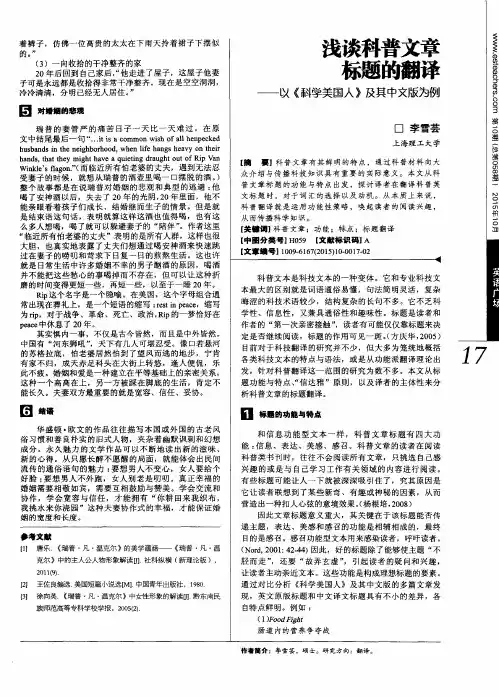

2019年托福听力科学美国人60秒:药品外表改变科学美国人60秒中英文翻译:药品外表改变Don't judge a book by its cover.And don't judge a pill by its color…or shape.When prescriptions for post-heart-attack care gotrefilled and the same drugs suddenly came in different shapes or colors, patients were significantly more likely to stop taking their meds.That's the finding from a study involving more than11,000 patients that appears in the Annals of Internal Medicine.药品.jpgEven when different looking pills contained the exact same active ingredient, a change in color boosted the odds that patients would stop taking their heart medication by 34 percent.A change in shape jumped the chance that patients would cease their meds by 66 percent.There's no legal requirement to make generic and brand-name drugs appear alike.But the study's authors say that the Food and Drug Administration should consider making consistent appearance the standard, as such uniformity would likely result in more patients adhering to their medication regimens.For now, we're all stuck reading pharmaceutical labels.科学美国人60秒中文翻译:不要从封面来判断一本书的好坏,当然也不能凭借颜色和形状来判断一片药。

第一单元什么是罗素悖论?约翰·T·鲍德温,奥利弗·莱斯曼撰胡志国译罗素悖论是建立在这样的实例基础之上的:想象有一群理发师,他们(给所有,而且)只给不给自己刮胡子的人刮胡子。
假设这个集体中有一个理发师,他不给自己刮胡子,那么,按照这个集体的定义,他就必须给自己刮胡子。
但这个集体中的任何理发师都不能给自己刮胡子。
(否则,他就是在给自己刮胡子的人刮胡子了。
)伯特兰·罗素1901年发现的这个悖论是对他的一位数学同行的打击。
十九世纪晚期,戈特洛布·弗雷格试图通过符号逻辑为所有的数学建立一个基础。
他在形式表达式(如x=2)和数学特征(如偶数)之间建立了一种对应关系。
在他的推导中,人们可以随意使用任何特征为后来的特征定义。
罗素在他1903年出版的《数学原理》中公布了自己的悖论,证明了弗雷格系统存在根本缺陷。
在今天看来,这类系统最好通过所谓的集的结构式用集合的概念来描述。
例如,对于由数字4、5、6组成的集体,我们可以描述为:x是一个整数的集体,若用字母n表示这些整数,则n大于3小于7。
对这一集合的描述,在形式上我们写作x={n: n为整数,3<n<7}。
集合的对象不一定是数字。
我们可以设y={x:x为美国男性居民}。
很明显,对x的任何描述都可以填入冒号后的区域。
但罗素(恩斯特·策梅洛也独立地)发现,x={a: a不属于a}会导致矛盾的结论,就像对理发师集体的描述一样。
x自身是否属于x?无论是与否,结论都是矛盾的。
罗素发现这一悖论之后,弗雷格马上认识到他的系统被全盘推翻了。
即便如此,他无法解决这个悖论,而为了绕开这个悖论,人们在二十世纪做了许多尝试。
罗素本人对这一悖论的回答是他的“类型论”。
他分析道,之所以会产生悖论,是因为我们混淆了对数的集合的描述与对数的集合的集合的描述。
于是罗素引入了对象的分级系统:数,数的集合,数的集合的集合,等等。
这个系统曾被作为手段用于对数学基础的第一次形式化,并且在今天的某些哲学研究和计算机分支学科中仍有运用。
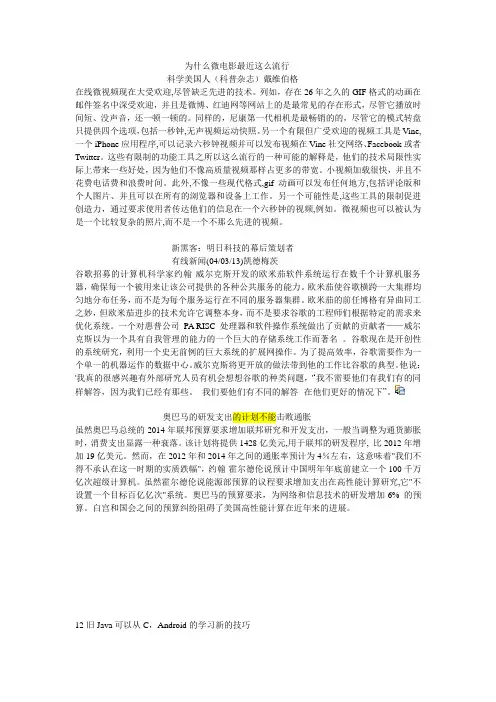
为什么微电影最近这么流行科学美国人(科普杂志)戴维伯格在线微视频现在大受欢迎,尽管缺乏先进的技术。
列如,存在26年之久的GIF格式的动画在邮件签名中深受欢迎,并且是微博、红迪网等网站上的是最常见的存在形式,尽管它播放时间短、没声音,还一顿一顿的。
同样的,尼康第一代相机是最畅销的的,尽管它的模式转盘只提供四个选项,包括一秒钟,无声视频运动快照。
另一个有限但广受欢迎的视频工具是Vine,一个iPhone应用程序,可以记录六秒钟视频并可以发布视频在Vine社交网络、Facebook或者Twitter。
这些有限制的功能工具之所以这么流行的一种可能的解释是,他们的技术局限性实际上带来一些好处,因为他们不像高质量视频那样占更多的带宽。
小视频加载很快,并且不花费电话费和浪费时间。
此外,不像一些现代格式,gif动画可以发布任何地方,包括评论版和个人图片、并且可以在所有的浏览器和设备上工作。
另一个可能性是,这些工具的限制促进创造力,通过要求使用者传达他们的信息在一个六秒钟的视频,例如。
微视频也可以被认为是一个比较复杂的照片,而不是一个不那么先进的视频。
新黑客:明日科技的幕后策划者有线新闻(04/03/13)凯德梅茨谷歌招募的计算机科学家约翰·威尔克斯开发的欧米茄软件系统运行在数千个计算机服务器,确保每一个被用来让该公司提供的各种公共服务的能力。
欧米茄使谷歌横跨一大集群均匀地分布任务,而不是为每个服务运行在不同的服务器集群。
欧米茄的前任博格有异曲同工之妙,但欧米茄进步的技术允许它调整本身,而不是要求谷歌的工程师们根据特定的需求来优化系统。
一个对惠普公司PA RISC 处理器和软件操作系统做出了贡献的贡献者——威尔克斯以为一个具有自我管理的能力的一个巨大的存储系统工作而著名。
谷歌现在是开创性的系统研究,利用一个史无前例的巨大系统的扩展网操作。
为了提高效率,谷歌需要作为一个单一的机器运作的数据中心。
威尔克斯将更开放的做法带到他的工作比谷歌的典型。
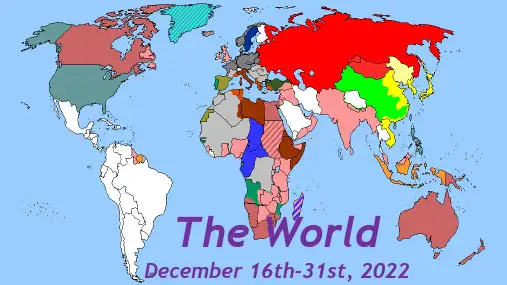
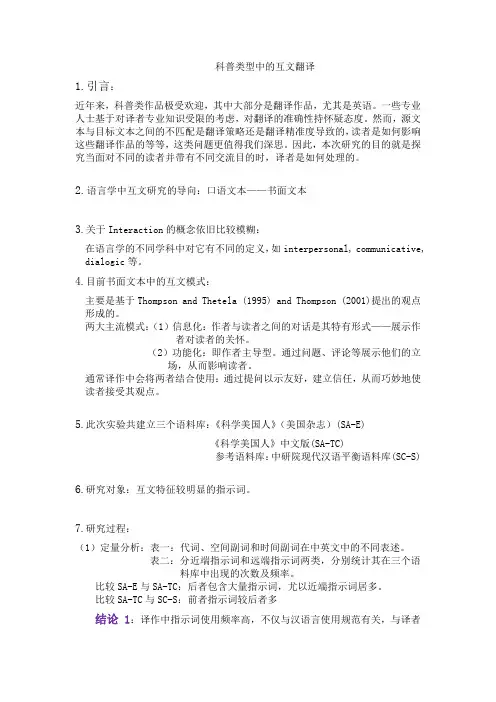
科普类型中的互文翻译1.引言:近年来,科普类作品极受欢迎,其中大部分是翻译作品,尤其是英语。
一些专业人士基于对译者专业知识受限的考虑,对翻译的准确性持怀疑态度。
然而,源文本与目标文本之间的不匹配是翻译策略还是翻译精准度导致的,读者是如何影响这些翻译作品的等等,这类问题更值得我们深思。
因此,本次研究的目的就是探究当面对不同的读者并带有不同交流目的时,译者是如何处理的。
2.语言学中互文研究的导向:口语文本——书面文本3.关于Interaction的概念依旧比较模糊:在语言学的不同学科中对它有不同的定义,如interpersonal, communicative, dialogic等。
4.目前书面文本中的互文模式:主要是基于Thompson and Thetela (1995) and Thompson (2001)提出的观点形成的。
两大主流模式:(1)信息化:作者与读者之间的对话是其特有形式——展示作者对读者的关怀。
(2)功能化:即作者主导型。
通过问题、评论等展示他们的立场,从而影响读者。
通常译作中会将两者结合使用:通过提问以示友好,建立信任,从而巧妙地使读者接受其观点。
5.此次实验共建立三个语料库:《科学美国人》(美国杂志)(SA-E)《科学美国人》中文版(SA-TC)参考语料库:中研院现代汉语平衡语料库(SC-S)6.研究对象:互文特征较明显的指示词。
7.研究过程:(1)定量分析:表一:代词、空间副词和时间副词在中英文中的不同表述。
表二:分近端指示词和远端指示词两类,分别统计其在三个语料库中出现的次数及频率。
比较SA-E与SA-TC:后者包含大量指示词,尤以近端指示词居多。
比较SA-TC与SC-S:前者指示词较后者多结论1:译作中指示词使用频率高,不仅与汉语言使用规范有关,与译者个人的偏好与选择也有密不可分的关系。
(2)定性分析:以一段文字为例,翻译成汉语后再返译回英文,此时第一段末尾多了一句承接句。
科学美国人杂志可靠性近日,美国科普杂志《科学美国人》(ScientificAmerican)发表了一篇题为《代售:在权威科学杂志上挂上你的名字》的调查文章,揭露国际科学期刊上学术论文造假的现象,文章指出,有100篇以上的中国作者发表的医学相关论文可疑性较大,可能是由“论文工厂”批量“生产”出来的。
《科学美国人》文章对此的描述是:这是100篇玩“填词游戏”的论文,论文中有部分段落与其他论文完全雷同,只存在个别字词的改变,但并不意味着它们一定出自“论文工厂”之手,也不意味着一定存在抄袭,但我们认为出版商有必要对其仔细审查。
当事作者回应:仅凭简单检索就怀疑抄袭太不负责根据报道提供的论文名单,联系了几位被曝光论文的作者和知情人士,有作者质疑《科学美国人》报道的可靠性。
在“百人名单”之中,不乏有多次“上榜”的作者。
其中,以“QiliuPeng”为第一署名作者的论文共7篇,分别刊登于《公共科学图书馆期刊》(PLoSONE)、《诊断病理学》(DiagnosticPathology)等国际期刊之上。
经核实,“QiliuPeng”中文名为彭契六,为广西医科大学第一附属医院博士研究生。
致电彭契六所在医学院教务部,一位不愿具名的工作人员称,名单上的“QiliuPeng”确系该校2012级临床检验诊断学博士研究生,至于论文涉嫌抄袭一事,对方不愿多谈,只是简单回应“这只是参考英语表达而已,并不是抄袭”。
就职于广州医科大学附属第三医院的潘兆军也出现在这份名单上,他发表于《亚太癌症预防杂志》(AsianPacificJournalofCancerPrevention)的论文被指涉嫌抄袭段落。
联系其所在科室,被告知对方正在进行手术,无法接受询问。
同样上榜的中国医科大学第一附属医院肿瘤内科医生滕赞(ZanTeng)回应时称,自己不存在抄袭行为,并质疑《科学美国人》的报道,认为该报道通过简单的检索程序就认定论文存在抄袭,是不负责任的表现,并表示“我们也在调查整件事情的进展,将保留追究其法律责任的权利。
科技英语阅读1-8单元译文:Unit 1罗素悖论的提出是基于这样的一个事例:设想有这样一群理发师,他们只给不给自己理发的人理发。
假设其中一个理发师符合上述的条件,不给自己理发;然而按照要求,他必须要给自己理发。
但是在这个集合中没有人会给自己理发。
(如果这样的话,这个理发师必定是给别人理发还要给自己理发)1901年,伯特兰·罗素悖论的发现打击了他其中的一个数学家同事。
在19世纪后期,弗雷格尝试发展一个基本原理以便数学上能使用符号逻辑。
他确立了形式表达式(如:x =2)和数学特性(如偶数)之间的联系。
按照弗雷格理论的发展,我们能自由的用一个特性去定义更多更深远的特性。
1903年,发表在《数学原理》上的罗素悖论从根本上揭示了弗雷格这种集合系统的局限性。
就现在而言,这种类型的集合系统能很好的用俗称集的结构式来描述。
例如,我们可以用x代表整数,通过n 来表示并且n大于3小于7,来表示4,5,6这样一个集合。
这种集合的书写形势就是:x={n:n是整数,3<n<7}。
集合中的对象并不一定是数字。
我们也可让y={x:x是美国的一个男性居民}。
表面上看,似乎任何一个关于x的描述都有一个符合要求的空间。
但是,罗素(和策梅洛一起)发现x={a:a不再a中}导致一个矛盾,就像对一群理发师的描述一样。
x它本身是在x的集合中吗?否定的答案导致了矛盾的出现。
当罗素发现了悖论,弗雷格立即就发现悖论对他的理论有致命的打击。
尽管这样,他还不能解决这个问题,并且上世纪有很多的尝试,去解决这个问题(但没有成功)。
罗素自己对这个悖论的回答促进了类型理论的形成。
他解释说,悖论的问题在于我们混淆了数集和数集的集合。
所以,罗素介绍了对象的分级系统:数、数集、数集的集合等等。
这个系统为形式化数学的形成奠定了基础,至今它还应用于哲学研究和计算机科学分支。
策梅洛对于罗素悖论的解决方法用新的公理:对于任意公式A(x)和任意集合b,都会有一个集合满足y={x:x既在b中又满足A(x)}取代了以前的公理:对于任意公式A(x),都会有一个集合满足y={x:x满足A(x)}。
《科学美国人》:语言能影响人的收入和健康?2013-03-25一项国际研究显示语言不仅决定我们如何思考未来,还决定我们如何计划未来。
语言能影响人的收入和健康?一项国际研究显示语言不仅决定我们如何思考未来,还决定我们如何计划未来奥兹冈·阿塔索埃我们说的话真能决定我们有多少钱,身体多棒么?耶鲁大学商学院的陈基斯(Keith Chen)在他的新研究里表明答案是肯定的。
我们说话的语言结构影响我们对未来的判断力和决策力,这对我们的未来影响深远。
有许多研究深入调查人类是如何对待未来的。
例如,华特·米歇尔与其同事共建的著名的棉花糖实验告诉我们:有无抵抗诱惑的能力是未来能否成功的关键指标。
实验中,他和同事们在四岁大的孩子们面前摆上棉花糖,每人一颗,然后告诉他们:如果谁能不吃这颗棉花糖、而且能等到工作人员出去再回来,那他就能得到两颗棉花糖。
该实验的后续研究显示那些能坚持并等待更大的奖赏的孩子们进入青年后比其他孩子更有作为。
学会抵制及时享乐这种冲动,几乎是人们达成人生重要目标的必由之路。
有些人既想要魔鬼身材又不肯舍弃最后一块比萨。
既想要攒钱过一段安逸的退休生活,又想开豪车、周游世界、或者把那双日思夜想的鞋买到手。
也有比一般人更会延迟满足自己的人:这些人在积累财富和保持健康生活方式上更胜一筹。
他们既不太会冲动购物、也不会头脑一热就酗烟酗酒,更不会堕入不安全的性生活中。
据陈基斯最新研究成果显示,语言这项看似不起眼的因素,对人们关乎未来的所有决策行为都会产生至关重要的影响。
一类语种将现在时态和将来时态划分甚明。
而另一类语种却不太强调“现在”和“将来”这两个概念。
他还强调,运用第二类语言的人更善于未雨绸缪:注重积累财富和健康资本。
这些人对“现在”和对“将来”这两个的概念的认知类似,因此,未来在他们眼里并不遥远,他们也更善于将未来目标与目前行动协调一致。
不同的语种对“将来”的表达方式不同。
像英语,韩语和俄语这些语言,要求明示将来时态。
2012年1月4日星期三雌激素是新的“利他林”吗?——性激素能让一部分女性思维敏捷,却也让一部分迟钝大考即将来临?无法集中注意力?尝试一点雌激素吧。
加州大学伯克利分校的神经系统科学家在最近的一项研究中报道称,女性生理周期中的荷尔蒙波动可能会如咖啡因、甲基苯丙胺或最常见的兴奋剂利他林一样影响其大脑。
近年来的研究表明,工作记忆(短期信息处理能力)是依赖于化学物质多巴胺的。
事实上,像利他林这样的药物可以模仿多巴胺帮助人们集中注意力。
在老鼠身上的研究显示,雌激素似乎可以诱发多巴胺的释放。
但是伯克利这次的新研究是首次把认识能力和人的雌激素水平联系起来,这也就解释了为什么有些女性会在她们生理周期的不同时间点有着或好或坏的认识能力。
这只研究团队对24名健康女性进行了检测。
通过基因测试,她们中有些天然多巴胺水平高,而有些天然低。
不出所料,多巴胺水平低的女性对于处理复杂的工作记忆问题有困难,比如将一串五个数字反着背出来。
但当测试在排卵期中进行,雌激素水平最高时(一般是月经期的10~12天后)这些女性的表现显著改善,有大约10%的进步。
令人惊讶的是,多巴胺水平天然高的女性处理复杂问题的能力,却在排卵期中雌激素水平最高的时候有很明显的下降。
根据组织此次研究的Ph.D Emily Jacobs说,脑中的多巴胺是“classic Goldilacks scenario”。
对于多巴胺水平最低的25%女性来说,在月经期多巴胺水平的增加会增强她们的认识能力,而对于多巴胺水平最高的25%女性来说,月经期多巴胺水平的增加可能会使她们的多巴胺水平超过一个上限,从而减弱她们的认识能力。
而剩下的50%女性都处在这两类女性水平之间,不在研究的范围内。
这项研究有着重大的意义。
Jacob说,像咖啡因、利他林这种诱发多巴胺释放的药物对于特定时期的女性是无效,甚至是损害性的。
而且,她还希望提醒科学家们注意,在研究脑部疾病时,男女大脑虽然天赋相同但是并不完全一样。
Jacob说,这之间有很大区别,只有我们能知道他们在正常状态下的区别,我们才能预测他们在疾病状态下的区别。
毁约——脑扫描揭示誓言什么时候会不被遵守新郎说“我愿意”而又和别人有一腿的时候,他脑中发生了什么?朋友承诺还钱却一直不还,他的脑中又发生了什么?一项最新研究显示,毁约是一项很复杂的神经生物学事件。
而且脑扫描可以在毁约发生前预测出谁将要毁约。
瑞士苏黎世大学的科学家运用核磁共振技术把大脑比喻成了一场投资游戏。
投资者必须决定是否承诺与受托者分享利益。
如果投资,会使得账户中的资金增加,但如果受托者选择不分享,结果也会是投资者受损失。
几乎所有投资者都说会把钱给受托者,但最后并不会所有人都守约。
通过核磁共振的扫描,研究者可以在他们有机会毁约前预测出他们会不会毁约。
毁约者脑部的一些区域的活动会更加活跃,包括分管在压抑诚实回应时自我控制的前额皮质层,和标志斗争及如愧疚和恐惧的负面情绪的杏仁核。
如果这种脑扫描的预测能力能在未来的研究中实现,有一天这个技术可以应用于司法系统。
Thomas Baumgartner说,脑成像技术可以帮助心理学家和精神病学家决定刑事罪犯是否可以释放及其重复犯罪的风险是否过高。
他还强调,这种脑扫描是健康专家的补充手段而不是替代手段。
一次学习永不忘——儿时学的语言会保存在脑中如果在小时候学的语言随着时间的流失忘记了会怎么样?许多的被收养者和移民对于他们的母语并没有有意识的记忆,但一项新的研究表明总会有一些信息存留在脑中的。
英格兰布里斯托大学的一个研究团队对于儿时学习过北印度语或祖鲁语的40岁以上说英语者做了调查,发现即使他们对此没有很明确的记忆,仍能够重新习得这些语言中很复杂的音,而儿时没有学过的人却不行。
因为记忆是通过日常使用的神经元联系得到加强的。
这项研究表明,即使这样的神经元联系多年没有使用,也不会完全消失,如前文所说。
2012年1月5日星期四消除恐惧——在回忆后的短时间内消除恐惧记忆是可能的当我们学习一些东西时,为了使其成为我们的记忆,必须将其印刻在我们的脑中,也就是所谓的“巩固(consolidation)”。
反过来,每次我们回忆一些东西时,都会“再巩固”,也就是会再给记忆增加一些信息。
纽约大学的心理学家Liz Phelps与其团队的研究将这种“再巩固”的方法用于消除人们的恐惧记忆,而不使用药物。
虽然克服恐惧记忆的技术已经存在一段时间了,但是它们都无法消除原始的恐惧记忆。
这些技术只是让人们拥有两个记忆,一个恐惧一个不恐惧,但是都会被一些东西触发从而再次想起。
但Phelps的最新研究不同。
在早先老鼠身上的实验表明,当记忆在“再巩固”阶段被改变时,原始的那个记忆就会被消除。
Phelps的团队利用温和的电击使得65名志愿者对屏幕上出现的某些方块产生恐惧感。
消除这种恐惧记忆的老办法是,让志愿者再次看到这些方块,但是没有电击,创造一个“方块是安全的”记忆。
Phelps的团队也这么做了。
但是对于其中的一些志愿者,研究人员让他们在再次看到方块前先对恐惧记忆进行至少10分钟的仔细回想。
这些志愿者的恐惧记忆就被新的安全的记忆所取代了。
当一年后再对他们进行方块电击实验时,他们很慢才重新对于方块产生恐惧。
相反的是,那些没有进行10分钟仔细回想的志愿者在他们重新进行方块点击实验时很快就想起了他们原来对于方块的恐惧感受。
研究人员推测,在回忆起来一件事约10分钟后,记忆才可能会进入“再巩固”阶段。
Phelps 补充到,“还有一些时间和空间的组合未能明确”,她也不知道“再巩固”阶段能够持续多久。
更加未知的是仔细回想在这个过程中扮演的角色,坐下来深思恐惧的记忆比简单的回忆更具有可塑性?虽然尚存诸多未知,Phelps和她的同事们都希望他们的研究能够帮助人们减弱恐惧和创伤后的精神紊乱。
给大脑画个妆——1个疗程重塑肌肉控制失调者的大脑熟能生巧。
正如很多研究表明,练习能够使人做的更好,也能给大脑上紧发条。
但是有时过多的练习会让发条太紧了,就像一些音乐家出现的肌张力障碍,症状是对肌肉间的界限认识不清而且不能精确移动肌肉。
对钢琴家来说,当他们想敲击一颗键时,手指可能会不自觉的向前抓。
这样的情况需要数年才能改善,但是一项最新的研究表明,可能只需要15分钟的治疗就能使音乐家们能够重新演奏。
伦敦学院大学的Karin Rosenkranz带领的团队对有肌张力障碍的钢琴家们的手部肌肉进行了振动治疗,每块肌肉2秒振动两秒休息,持续数轮。
15分钟的治疗后这些钢琴家们有了显著改善,和没有肌张力障碍的钢琴家们都差不多了。
研究团队使用脑颈颅磁刺激(TMS)的方法对这些钢琴家大脑的某些区域进行刺激,来探寻对手部肌肉进行振动治疗时脑部电信号是如何变化的。
对于肌张力障碍的人来说,振动一块肌肉会牵动周围几块肌肉,因为大脑中对每块肌肉的界限并不明确。
经过治疗,研究者证实每块肌肉分属的大脑神经片区更加清晰了。
如果延续旧的练习习惯,肌张力障碍可能复发。
但这种新治疗方法提供的临时改善可以使患病者有机会学习新方法或改变就习惯,从而避免复发。
加州大学的治疗师Nancy Byl说,“你必须学着去控制肌肉控制的失调。
”Byl给音乐家、运动员、管线工人和打字过于频繁的软件工程师等治疗过肌张力障碍。
她指出,过度练习只会导致重复性拉伤,一般还加上焦虑、压力或基因方面的因素才会导致肌张力障碍。
男人看重性,女人看重爱?——1项新的理论关于为什么人们对于不同种类的背叛表示猜疑猜疑对于夫妻关系来说是毁灭性的,大家也都知道得红眼病的怪兽是什么样。
根据以前的研究,男性更容易对性背叛产生猜疑,而女性对情感忠诚更看重。
最常使用的解释是一个不忠的伴侣可能会使男性为他人抚养后代,而遭男性背叛的女性可能会需要独自承担抚养后代的负担。
但宾夕法尼亚州立大学的一项新研究使我们要重新思考这个问题了。
在一项超过400人的实验中,临床心理学家Kenneth Levy和Kristen Kell发现,每个人由儿时经历形成的性格的差异解释了性别间猜疑模式的差异。
志愿者们被问同样一个问题,是他们的伴侣与别人发生性关系更令他难受还是他们的伴侣与别人建立起稳定的情感纽带更令他难受。
那些有一种叫“dismissing”的不安全依恋的男性和女性是最容易对性背叛表示猜疑的。
他们大多有反复无常或迟钝的父母,所以他们学会了避免亲密,达到“超独立”的状态。
这样的男性比女性多一些。
出现这种性别差异的原因还不明确,但可能与男权主义的文化观念有一定关系。
Levy说,依恋模式,也就是对个人成因的理解,似乎既可以解释男女之间对猜疑的差异,也可以解释为什么有些人符合异性的猜疑特征了。
2012年1月6日星期五走要走的轰轰烈烈——死前大脑的活动会波涛汹涌从濒死状态恢复过来的人总会有例如“记忆不断从眼前闪过”这样的感觉。
最近一项对濒死前大脑的检测可能会对这样的现象提供一些线索。
华盛顿大学药理中心的麻醉学家Lakhmir Chawla与他的同事们最近发布了一项报告,是对7名去除了生命维持设备,并且被麻醉的重病病人的脑活动进行的分析。
通过脑电图扫描器对神经系统的记录,Chawla发现,在人临死时会有一个短暂但强烈的波动,尽管之前会有血压的下降和脑活性的减弱。
“据我们所知,这样的现象是第一次被注意到。
当大多数人觉得你的大脑因为缺血而会生理性死亡时,这个现象就会发生。
”Chawla说。
这样的波动会持续30秒到180秒,并且会展现出一些有意识的情况例如发出伽马波。
在这样的波动减弱后,病人就被宣布死亡。
Chawla推测说,死前的脑波动可能十分短暂。
这“最后的欢呼”是因为脑部对缺氧所引起的。
活的脑细胞仍维持其电荷差,就像充电时电池的两极一样。
保持这样的极差是消耗能量的,而大脑中的能量创造是需要氧气的。
随着血流的减慢和氧气的流失,脑细胞不能维持极差的时候,它们就爆发了,引起脑中的一系列的波动。
如果这些波动发生在脑中的记忆区,那就可以解释为什么那些濒死的人会有丰富生动的回忆涌现。
更进一步的分析就比较困难了,因为这次研究只扫描了前脑,而且对于死前研究进行的并不多。
接下来,Chawla将与他的同事们对死前阶段进行更深入的研究,运用更复杂的成像技术,更多的人以及整个脑部。
别再懒散!——好的姿势能够激发自尊在你的成长过程中,你母亲可能会让你坐要坐的直,因为好的坐姿让你看起来自信而且给人留下好印象。
根据2009年10月《欧洲社会心理学》杂志的一项研究表明,好的坐姿对你的自尊也会有帮助。
研究人员让大学生们为自己打分,看他们是否适合做雇员。
那些被告知抬头挺胸坐的端正的学生给自己的分数会更高一些。
再一次,妈妈是对的。
手机辐射能保护记忆?——暴露在像手机这样的辐射下能够让老鼠避免老年痴呆症经过多年与手机可能诱发脑肿瘤的诉讼后,一些消息可能会受到产业代表的欢迎。